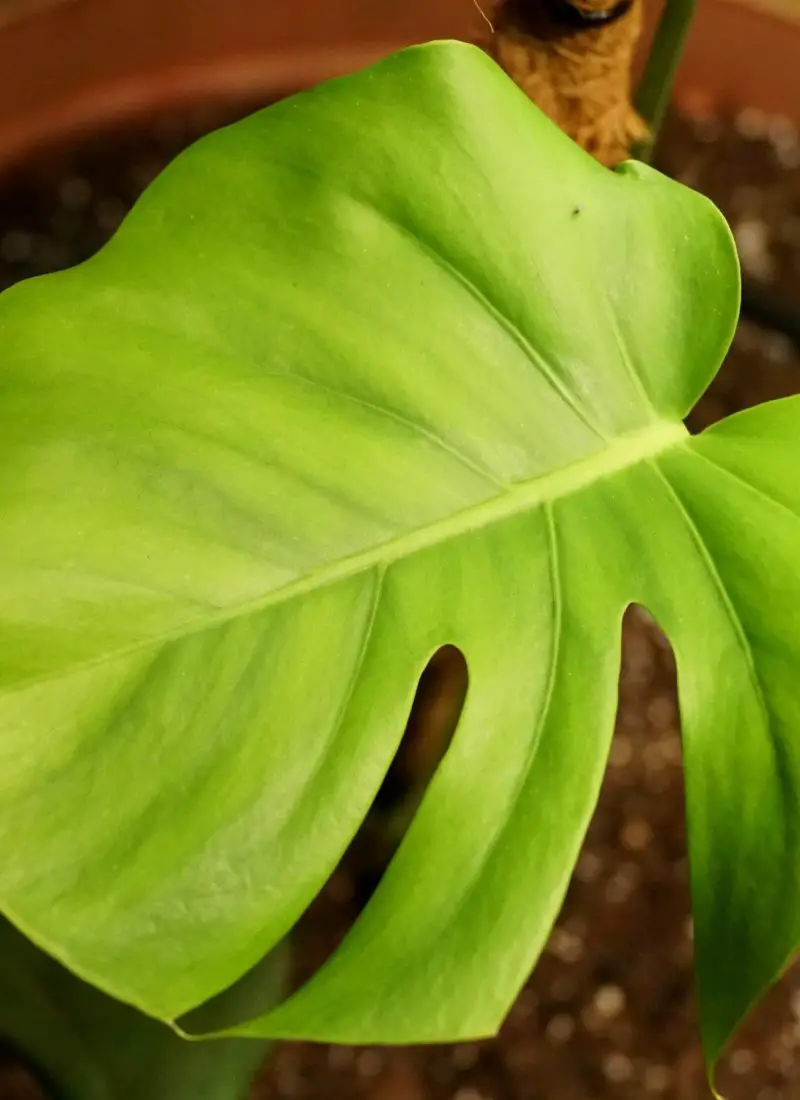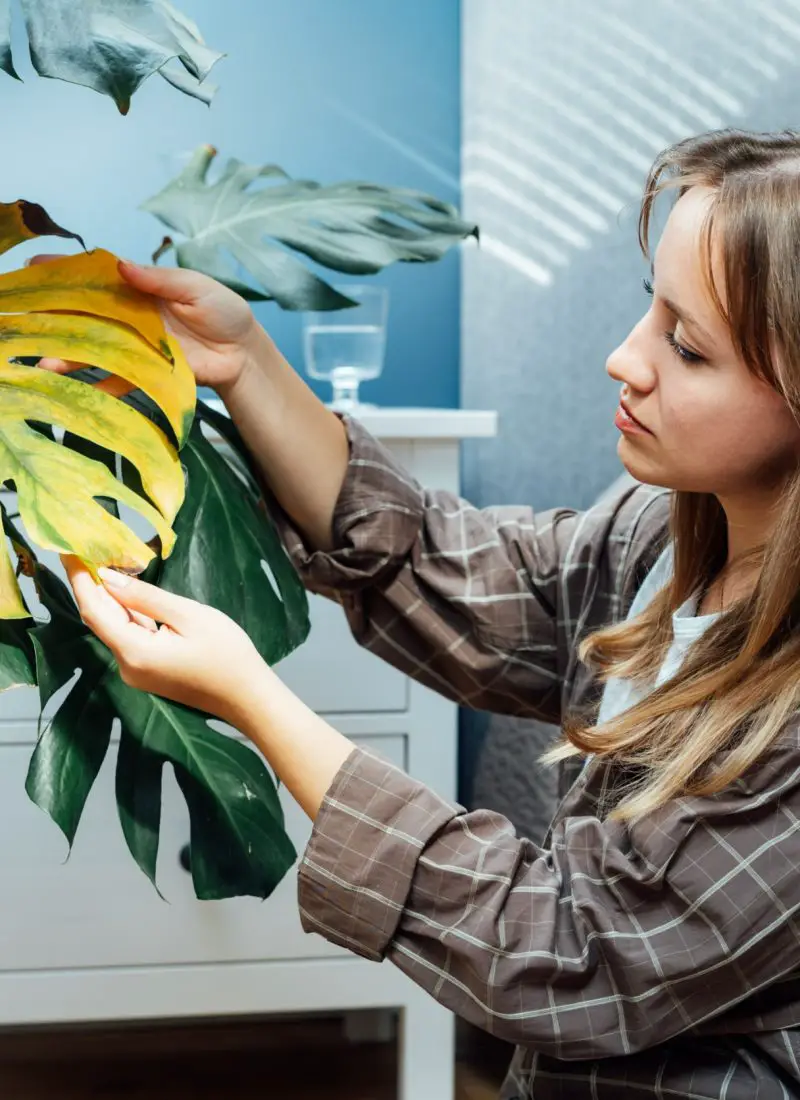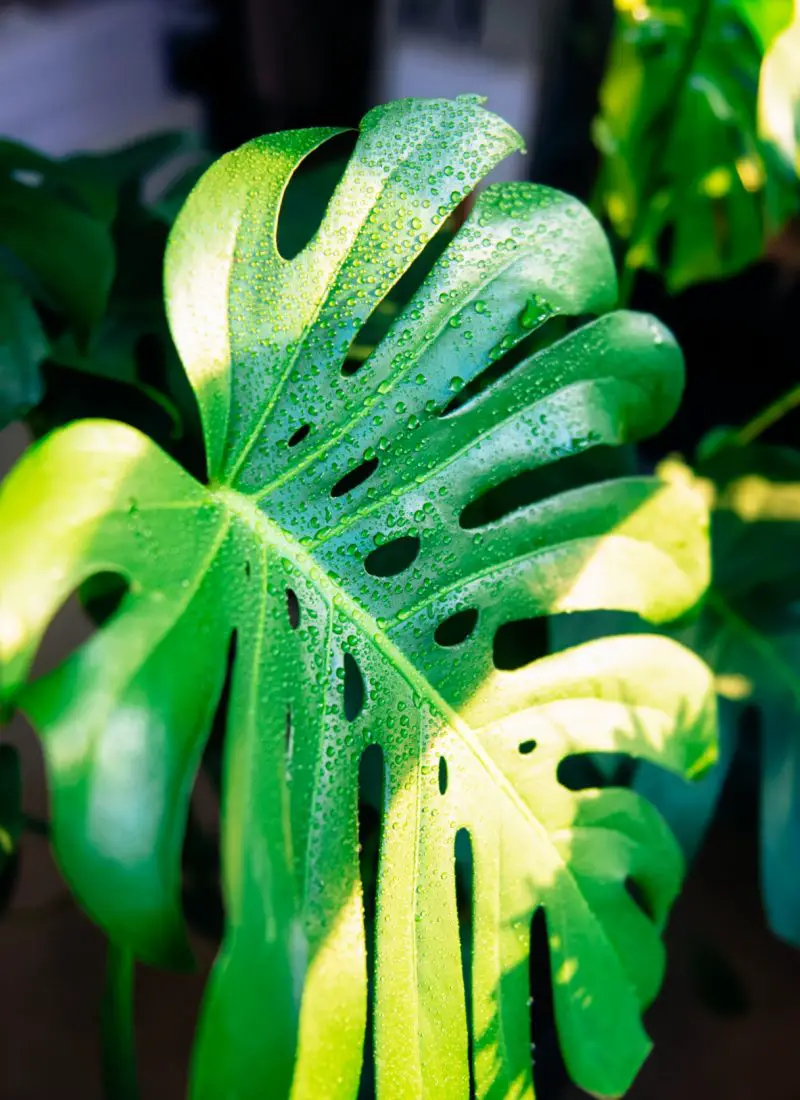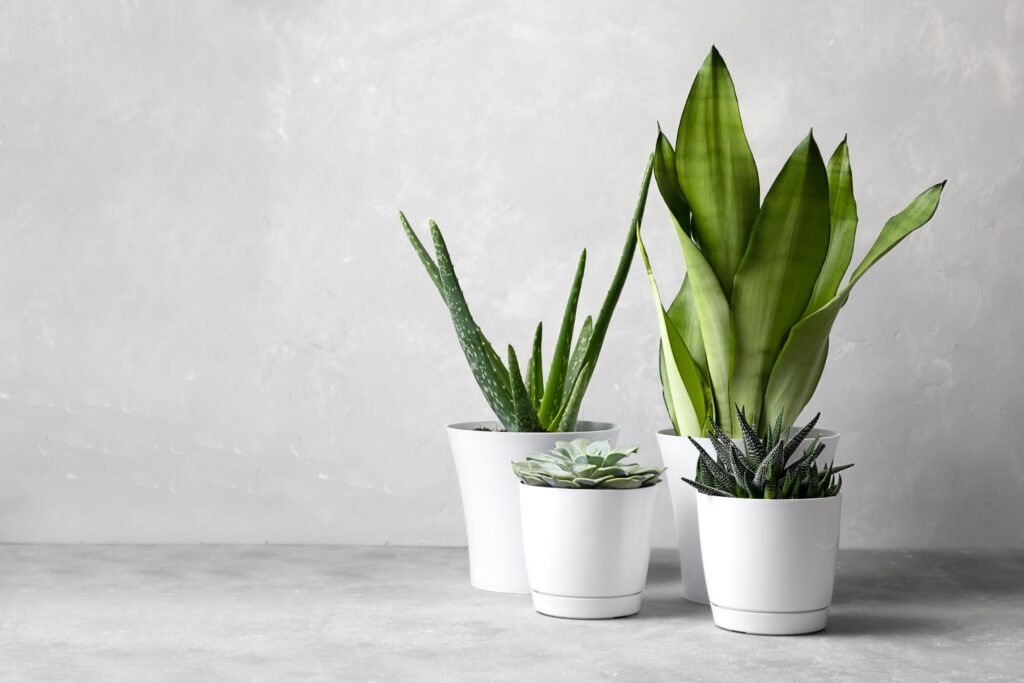
You may be a lazy gardener or just a beginner looking for an easy plant to care for. Preferably, something that’ll thrive on neglect, forgetful watering, and limited light. Well, you came to the right place because I’ve got just the list for you!
Oh and if you guys are looking to see if any of these plants can hold up inside with an indoor heater during the cold season, this article with our original experiment and data may interest you: Can You Put Indoor Plants Near a Heater? We Tested 19 Houseplants
Here are 11 houseplants that can handle some tough love while you’re busy living your life:
(As an Amazon Associate, I earn from qualifying purchases.)
Table of contents
- 1. African Milk Tree/Weed (Euphorbia Trigona)
- 2. Aloe Vera (Aloe Barbadensis/Aloe Perfoliata)
- 3. Corn Plant (Dracaena Fragrans)
- 4. Lucky Bamboo (Dracaena Sanderiana)
- 5. Mini Monstera/Philodendron Minima (Rhaphidophora Tetrasperma)
- 6. Monstera (Monstera Deliciosa)
- 7. Pothos (Epipremnum Aureum)
- 8. Snake Plant (Dracaena Trifasciata)
- 9. Spider Plant (Chlorophytum Comosum)
- 10. Zebra Cactus (Haworthia)
- 11. ZZ plant (Zamioculcas Zamiifolia)
1. African Milk Tree/Weed (Euphorbia Trigona)
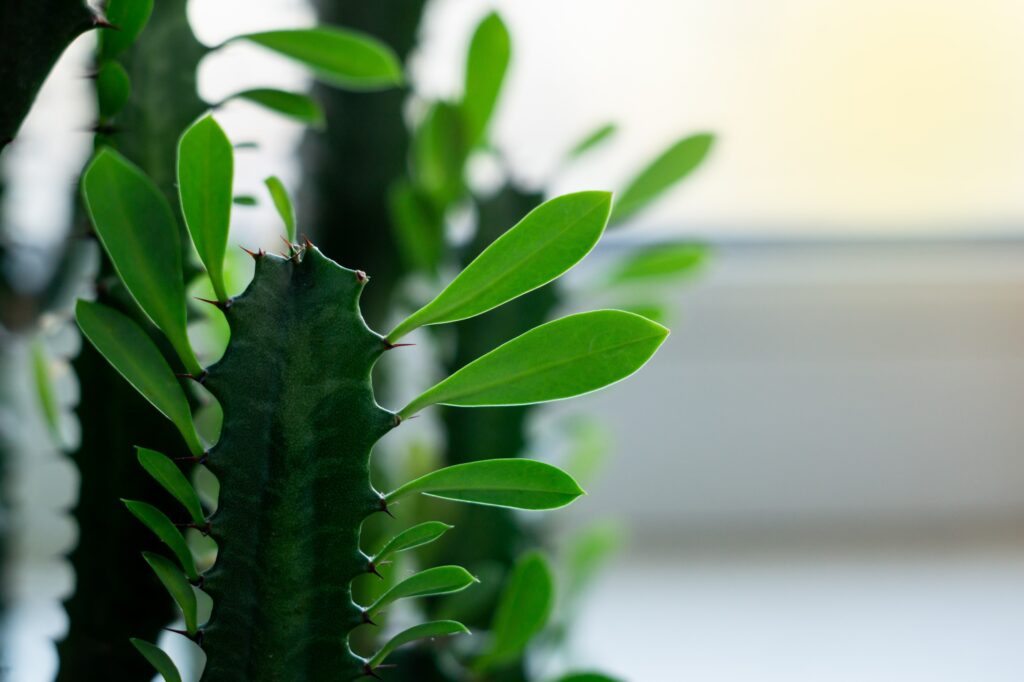
What is this plant? A funky looking cacti-but-is-actually-a-succulent with thorns and leaves growing on the sides. It’s often used in the landscape as a hedge but does well as a potted plant too.
What are its basic care needs?
- Sun: 6 to 8 hours of indirect sunlight.
- Soil: Well-draining, sandy soil.
- Water: Biweekly watering, after the soil has completely dried out.
- Fertilizer: Monthly feeding in spring and summer using a diluted liquid fertilizer.
- Special Care: Prune this plant to keep it at a manageable and balanced height so it doesn’t topple over as it has a shallow root system.
Any precautions about taking care of this plant? Like all cacti, be careful with its prickly parts and use gloves when pruning them. This is to also protect you from getting the milky saps in contact with your skin which is not only toxic to you and your pets, but also an irritant.
2. Aloe Vera (Aloe Barbadensis/Aloe Perfoliata)
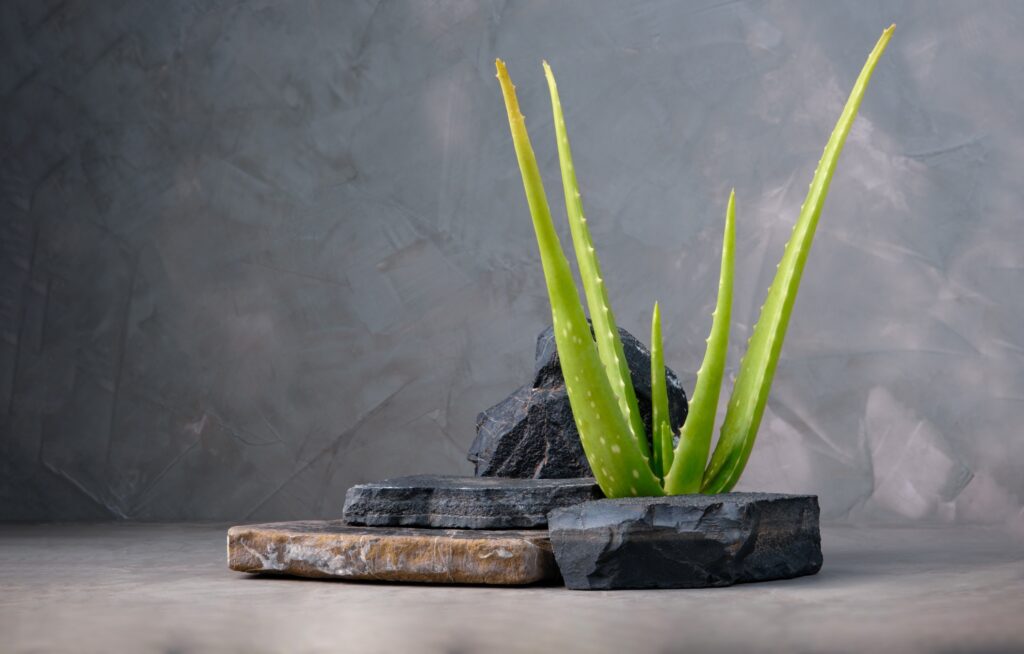
What is this plant? Short, fleshy and spiky stalks that bloom outwards like an angry, green flower.
What are its basic care needs?
- Sun: 6 to 8 hours of indirect sunlight.
- Soil: Well-draining soil.
- Water: Every 2 to 3 weeks, after the soil has completely dried out.
- Fertilizer: Yearly application of slow-release all-purpose fertilizer in early spring. Otherwise, it’s typically unnecessary.
- Special Care: Repot this plant once it starts getting bigger to encourage more growth. Otherwise, you can keep it small by leaving it in the same pot to restrict its development. Alternatively, you can remove offset or offsprings of the plant and grow it in its own pot.
Any precautions about taking care of this plant? Despite its popularity in drinks and medicine, do not readily consume the gel of your homegrown Aloe Vera. Leave it to the professionals to prepare them correctly for your use and let the plant grow as is.
3. Corn Plant (Dracaena Fragrans)
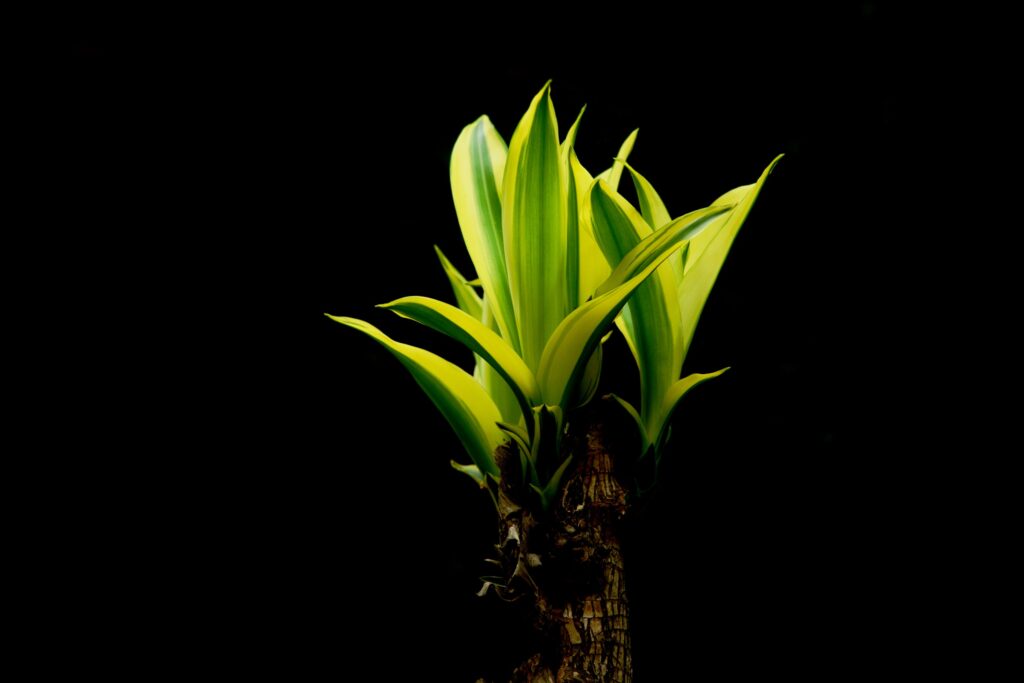
What is this plant? Like its namesake, it grows similarly to a corn stalk but without any corn in sight. But they come in different color variations and markings of green, cream, and yellow.
What are its basic care needs?
- Sun: 6 to 8 hours of indirect sunlight.
- Soil: Well-draining, loamy soil.
- Water: Biweekly watering after the soil has dried out halfway through.
- Fertilizer: Yearly application of slow-release all-purpose fertilizer in early spring.
- Special Care: None!
Any precautions about taking care of this plant? Keep your Corn Plant far away from the reach of children and pets as it is toxic upon ingestion.
Where can I read more about this plant?
- The Ultimate Dracaena Varieties & Cultivars Guide – with Pictures
- How to Save a Dying Dracaena (Corn Plant) – Pictures & All Possible Causes
4. Lucky Bamboo (Dracaena Sanderiana)
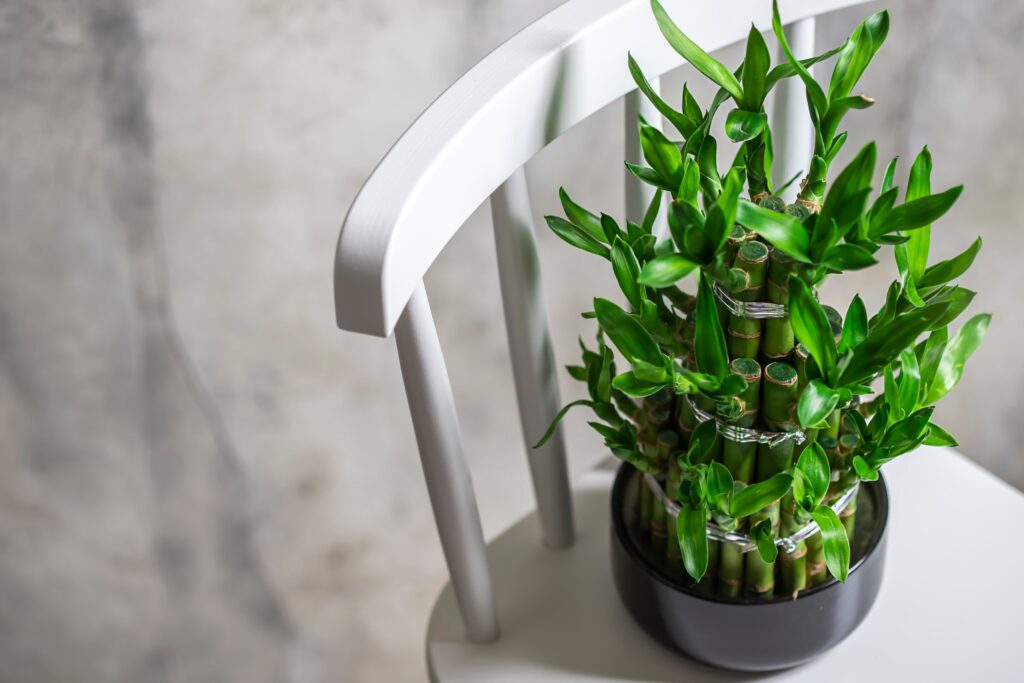
What is this plant? Despite its name, Lucky Bamboo is not a ‘true bamboo’ or even belonged to the same family. But its lovely spiraling and twisting stalks meticulously trained by growers add a fantastic look to your home.
What are its basic care needs?
- Sun: 6 to 8 hours of indirect sunlight.
- Soil: Well-draining soil. Alternatively, you can grow this plant in a glass or bowl of water filled with pebbles.
- Water: Weekly to biweekly watering after the soil is dried halfway through. Alternatively, change the water out completely once or twice a month.
- Fertilizer: Feed once every other month with a weak and diluted liquid fertilizer.
- Special Care: Trim shoots growing at the sides of the plant to maintain a balanced look.
Any precautions about taking care of this plant? Keep the Lucky Bamboo far away from the reach of children and pets as it is toxic upon ingestion.
5. Mini Monstera/Philodendron Minima (Rhaphidophora Tetrasperma)
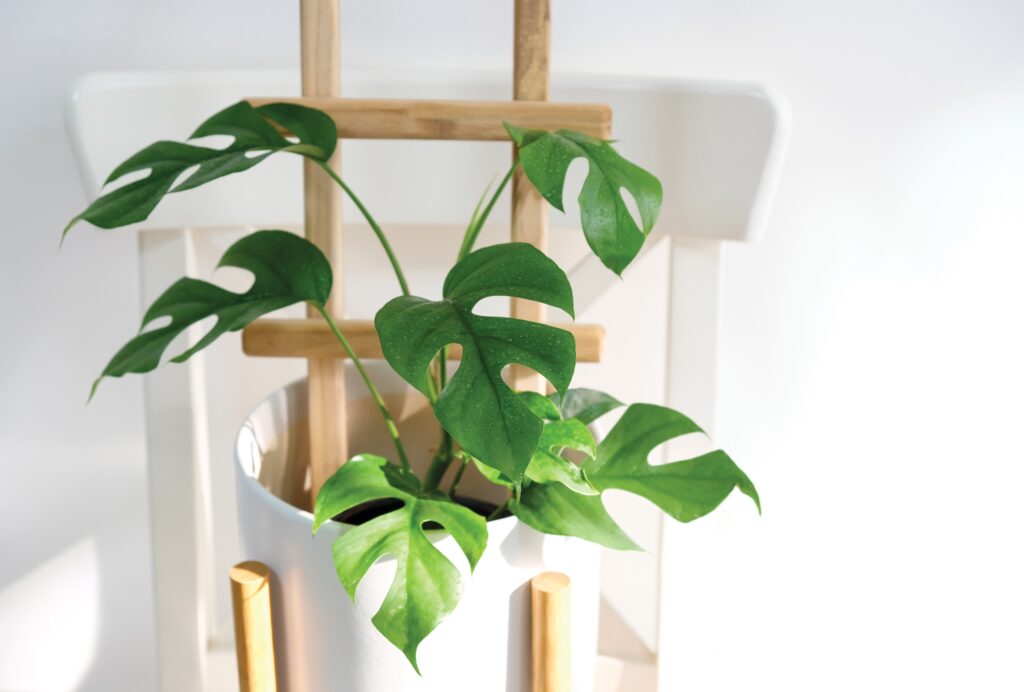
What is this plant? It looks like a tiny Monstera when grown but starts out looking like a Philodendron but surprise, surprise – it’s neither of those things! But it is related to both those plants, just under the ‘Rhaphidophora’ genus. If you don’t have the space for a giant Monstera, this plant may just fit your size.
What are its basic care needs?
- Sun: 6 to 8 hours of indirect sunlight.
- Soil: Well-draining soil filled with nutrients.
- Water: Weekly to biweekly watering, after the soil has dried halfway through.
- Fertilizer: Monthly feeding in spring and summer with a diluted liquid fertilizer.
- Special Care: Place a moss totem pole during the initial planting as a trellis support for the plant’s climbing growth.
Any precautions about taking care of this plant? None!
Where can I read more about this plant?
- What Is A Philodendron Minima? Here’s What You Need To Know
- Can You Fix Rhaphidophora Tetrasperma With a Broken Stem Easily?
- Can You Put Indoor Plants Near a Heater? We Tested 19 Houseplants
6. Monstera (Monstera Deliciosa)
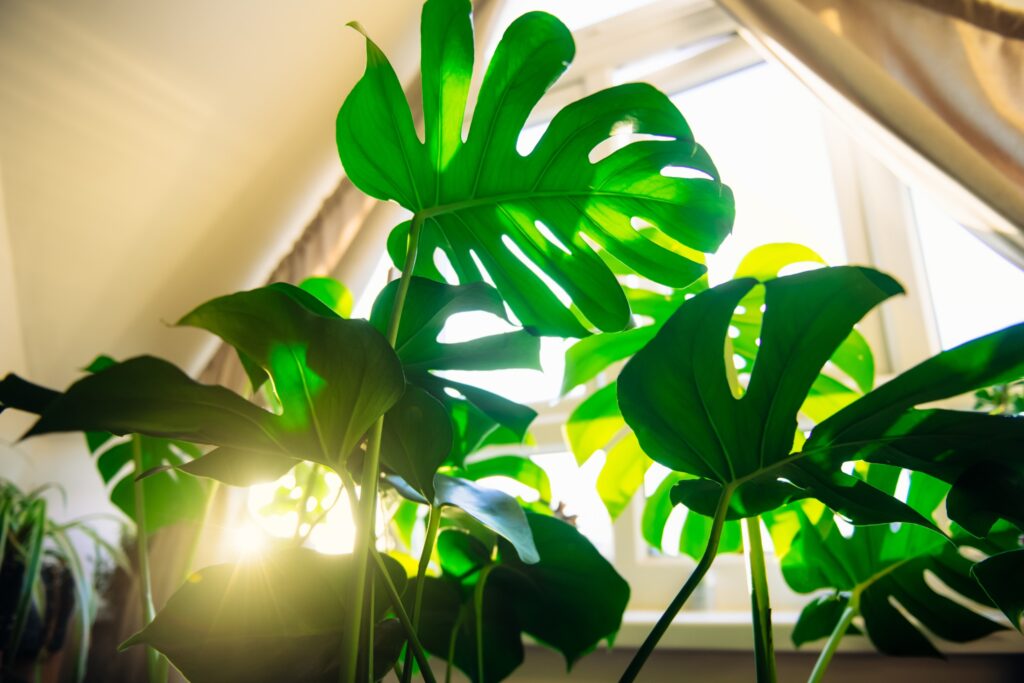
What is this plant? Large leaves with prominent fenestrations or splits at the sides, this plant is a staple in most plant owner’s homes, gladly taking up a corner of its own. It is certainly way easier to live with than a Fiddle Leaf Fig in comparison because it’s happy to do its own thing with occasional watering here and there.
What are its basic care needs?
- Sun: 6 to 8 hours of indirect sunlight.
- Soil: Well-draining, loamy soil filled with nutrients.
- Water: Weekly to biweekly watering, after the soil has dried out halfway through.
- Fertilizer: Yearly application of slow-release all-purpose fertilizer in early spring.
- Special Care: Add a moss totem pole during the initial planting to allow the plant’s vines to climb up and grow bigger split leaves. As this happens, you’ll need to repot the plant once every 1-2 years to accommodate its large growth.
Any precautions about taking care of this plant? Keep this plant far away from the reach of children and pets as it is toxic upon ingestion and may even cause skin irritation.
Where can I read more about this plant?
- Training an Indoor Monstera to Climb – With Helpful Tips
- Are Terracotta Pots Good For Monsteras? – With Helpful Tips
- Do Monsteras Like To Be Misted To Grow Better?
7. Pothos (Epipremnum Aureum)
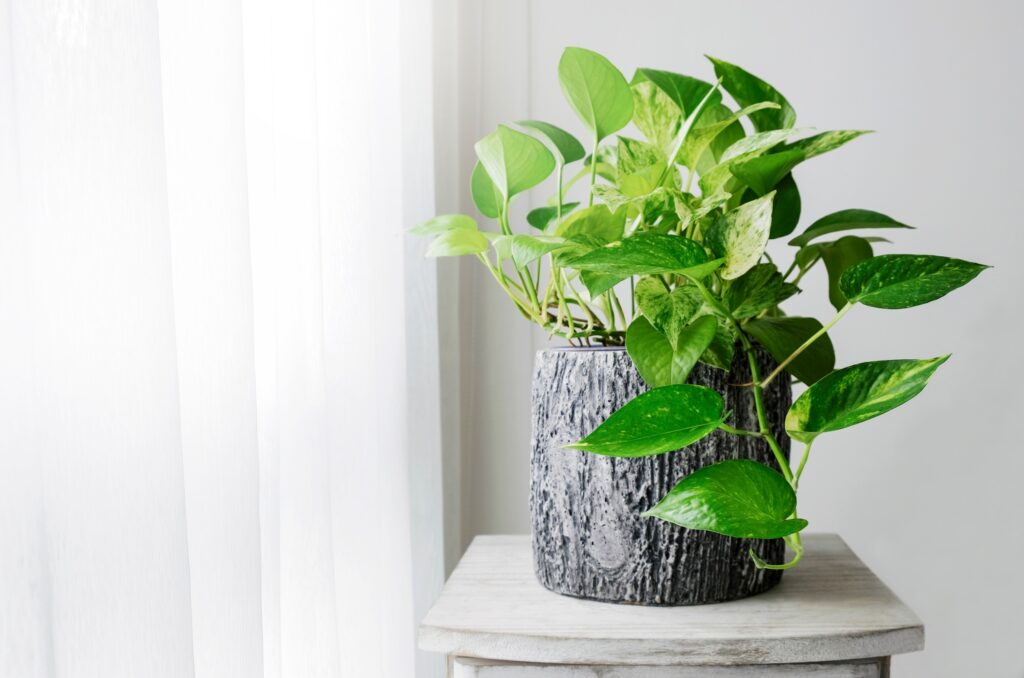
What is this plant? Pothos is the plant darling of the houseplant collective, available in varying cultivars of green, neon green, yellow, and white. It’s the classic indoor plant with its heart-shaped leaves and long vines which you can grow as a hanging/trailing plant from the ceiling.
What are its basic care needs?
- Sun: 6 to 8 hours of indirect sunlight.
- Soil: Wet, well-draining soil. Alternatively, you can also grow the plant in a shallow pool of water.
- Water: Weekly to biweekly watering, after the soil has dried out halfway through.
- Fertilizer: Feed once every 3 months in spring and summer with a diluted liquid fertilizer.
- Special Care: Prune this plant back if it’s getting a little too unruly or take stem cuttings and grow them in a different pot.
Any precautions about taking care of this plant? Keep Pothos far away from the reaches of children and pets as it is toxic upon ingestion, being particularly careful with the sap as it may cause irritation to the skin.
Where can I read more about this plant?
- Do Pothos Plants Like To Be Misted? (All You Need To Know)
- How to Make Pothos Fuller: The Ultimate Guide
- Can I Save My Beautiful Pothos From Root Rot?
8. Snake Plant (Dracaena Trifasciata)
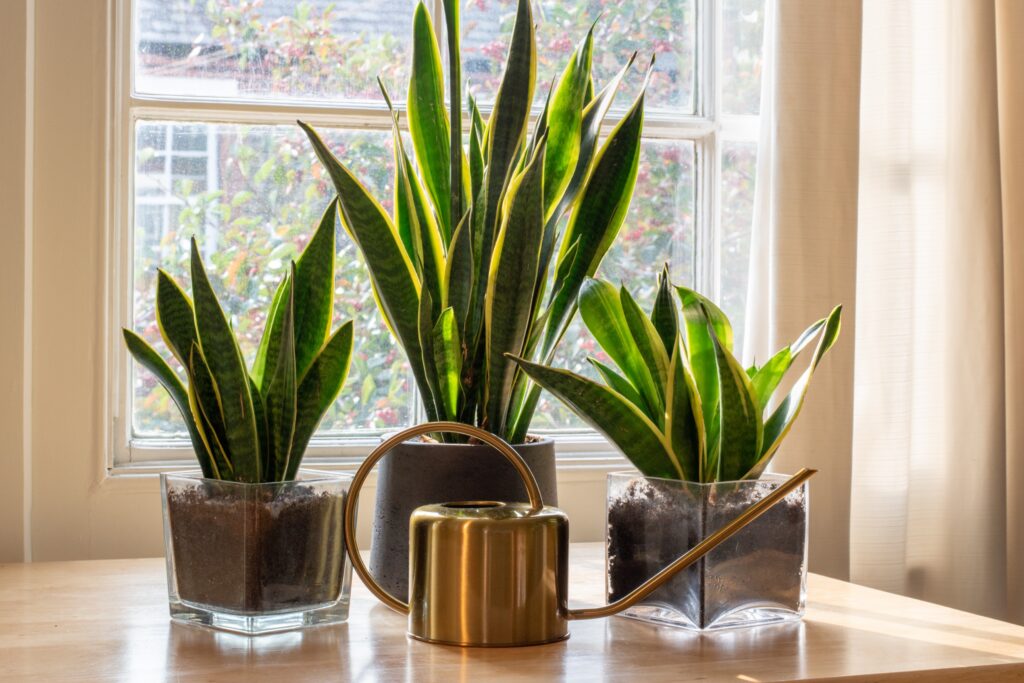
What is this plant? Resembling a flattened snake, this resilient plant is probably the most unkillable plant in this whole list. You can throw so many things at it and this Snake plant will still persevere! Its fleshy and firm leaves come in varying patterns of yellow, light and dark green, ending on a tapered point at the top.
What are its basic care needs?
- Sun: 6 to 8 hours of indirect sunlight.
- Soil: Well-draining soil.
- Water: Biweekly watering, after the soil has completely dried out.
- Fertilizer: Feed once every 2 months in spring and summer with a diluted liquid fertilizer.
- Special Care: Grow this plant in a large and tall container to prevent it from toppling over, preferably in plastic as it may crack a terracotta/ceramic pot eventually.
Any precautions about taking care of this plant? Keep this plant far away from the reaches of children and pets as it is toxic upon ingestion.
Where can I read more about this plant?
- Do Snake Plants Need Drainage Holes? The Truth You Need to Know
- Can You Put Indoor Plants Near a Heater? We Tested 19 Houseplants
9. Spider Plant (Chlorophytum Comosum)
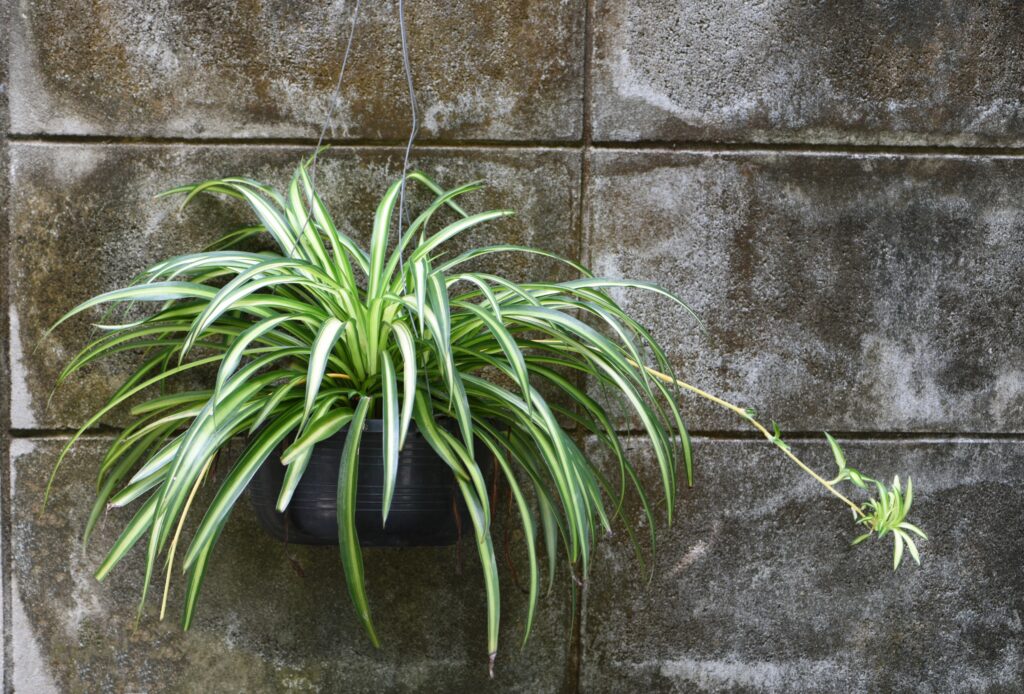
What is this plant? A harmless spider-looking plant with green, white, yellow leaf streaks. It grows with such abundance and naturally effortless volume, you’d think it blow-dries its hair daily without damaging its plant follicles. But I do not recommend using it as a wig.
What are its basic care needs?
- Sun: 6 to 8 hours of indirect sunlight.
- Soil: Well-draining soil.
- Water: Every 2 to 3 weeks, after the soil has completely dried out.
- Fertilizer: Feed once every 3 months in spring and summer using a diluted liquid fertilizer.
- Special Care: Remove offsets or plantlets once it’s ⅓ of the mother plant’s size and grow it in its own pot.
Any precautions about taking care of this plant? None.
10. Zebra Cactus (Haworthia)
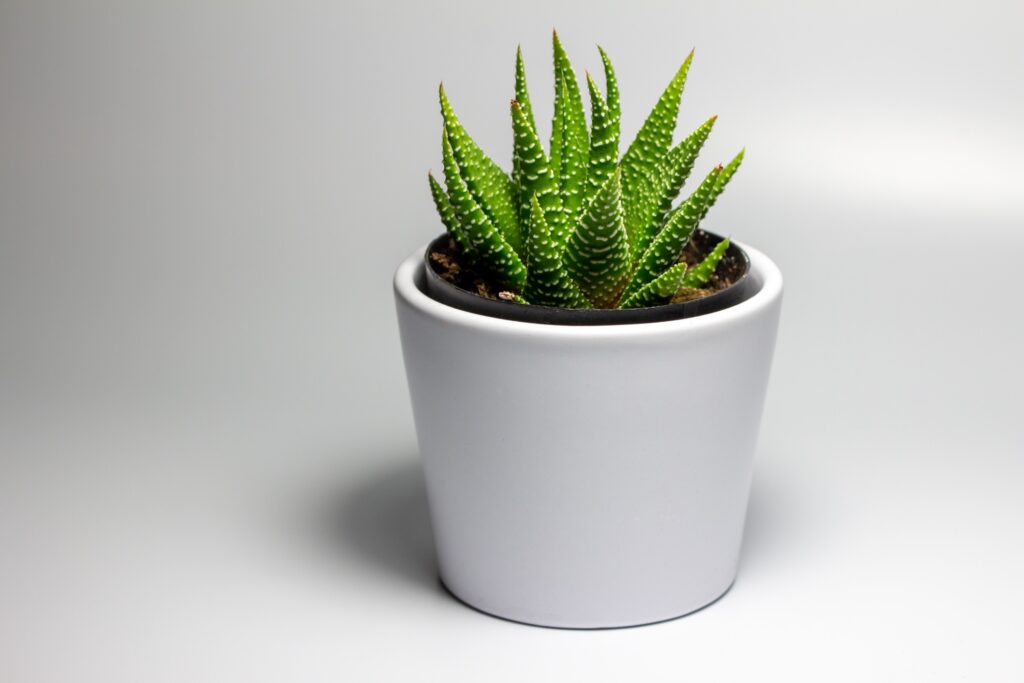
What is this plant? Similar to an Aloe Vera, a Zebra Cactus is fleshier and has a zebra pattern across each stem. In rare occasions, they may even send out a long tendril with tiny flowers on them!
What are its basic care needs?
- Sun: 6 to 8 hours of indirect sunlight.
- Soil: Well-draining, sandy soil.
- Water: Weekly to biweekly watering, after the soil has completely dried out.
- Fertilizer: Unnecessary.
- Special Care: None!
Any precautions about taking care of this plant? None!
Where can I read more about this plant?
11. ZZ plant (Zamioculcas Zamiifolia)
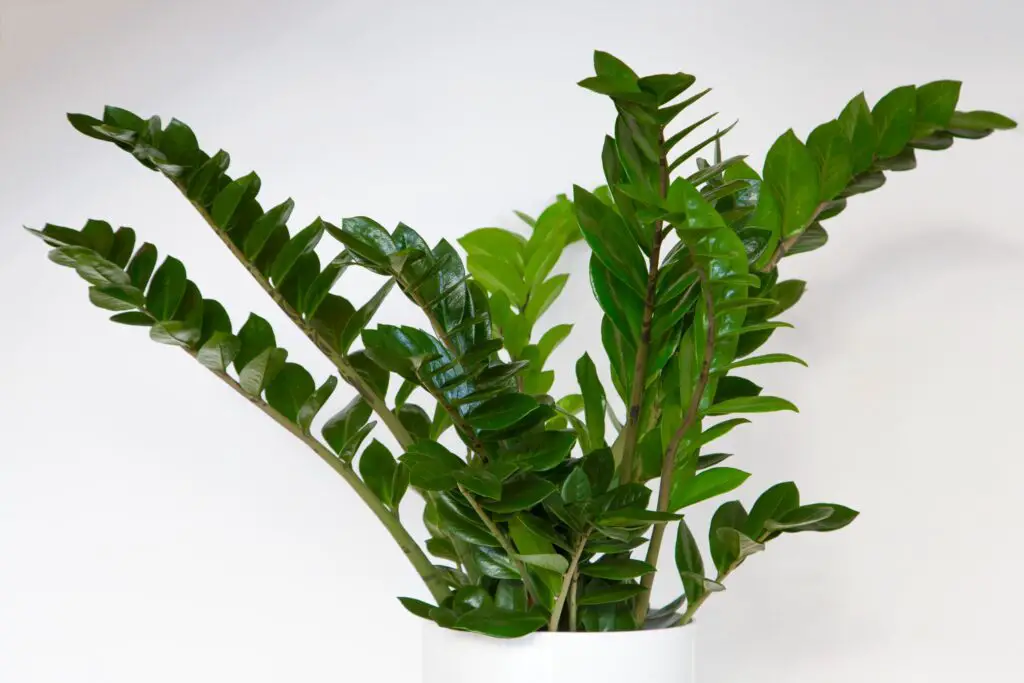
What is this plant? With multiple glossy green leaves lined up symmetrically on upright stems, this plant is a simple beauty with no frilly edges. It also kind of looks like multiple branches jammed together in a pot but in a good way.
What are its basic care needs?
- Sun: 6 to 8 hours of indirect sunlight.
- Soil: Well-draining soil.
- Water: Every 2 to 3 weeks, after the soil has dried out halfway through.
- Fertilizer: Yearly application of slow-release all-purpose fertilizer in early spring.
- Special Care: None!
Any precautions about taking care of this plant? Keep ZZ plants far away from the reaches of children and pets as it is toxic upon ingestion.
Where can I read more about this plant?
References:
- Aloe vera (Aloe, Aloe Vera, Barbados Aloe, Medicinal Aloe, Medicine Plant, True Aloe) | North Carolina Extension Gardener Plant Toolbox. (n.d.). Plants.ces.ncsu.edu. https://plants.ces.ncsu.edu/plants/aloe-vera/
- Dracaena fragrans (Corn Plant, Cornstalk Plant, Dracaena, Dragon Tree, janet craig plant, Ribbon Plant, Striped Dracaena, Striped Dragon Palm, Warneckei Dracaena, warneckii) | North Carolina Extension Gardener Plant Toolbox. (n.d.). Plants.ces.ncsu.edu. https://plants.ces.ncsu.edu/plants/dracaena-fragrans/
- Dracaena sanderiana (Chinese Water Bamboo, Friendship Bamboo, Lucky Bamboo, Ribbon Plant, Water Bamboo) | North Carolina Extension Gardener Plant Toolbox. (n.d.). Plants.ces.ncsu.edu. https://plants.ces.ncsu.edu/plants/dracaena-sanderiana/
- Haworthia (Pearl Plant, Star Window Plant, Zebra Cactus) | North Carolina Extension Gardener Plant Toolbox. (n.d.). Plants.ces.ncsu.edu. Retrieved December 22, 2022, from https://plants.ces.ncsu.edu/plants/haworthia/
- Mahr, S. (n.d.). Pothos, Epipremmum aureum. Wisconsin Horticulture. https://hort.extension.wisc.edu/articles/pothos-epipremmum-aureum/
- Monstera deliciosa (Ceriman, Cutleaf Philodendron, Hurricane Plant, Mexican Breadfruit, Mother-in-Law, Split-leaf Philodendron, Swiss Cheese Plant) | North Carolina Extension Gardener Plant Toolbox. (n.d.). Plants.ces.ncsu.edu. https://plants.ces.ncsu.edu/plants/monstera-deliciosa/
- New and Newsworthy Indoor Plants. (2021). Psu.edu. https://extension.psu.edu/new-and-newsworthy-indoor-plants
- Rojas-Sandoval, J. (2022). Euphorbia trigona (African milk weed). CABI Compendium, CABI Compendium. https://doi.org/10.1079/cabicompendium.21380
- Snake Plant: A Forgiving, Low-maintenance Houseplant. (2021). Psu.edu. https://extension.psu.edu/snake-plant-a-forgiving-low-maintenance-houseplant
- Spider plant, Chlorophytum comosum. (n.d.). Wisconsin Horticulture. https://hort.extension.wisc.edu/articles/spider-plant-chlorophytum-comosum/
- ZZ Plant – Gardening Solutions – University of Florida, Institute of Food and Agricultural Sciences. (n.d.). Gardeningsolutions.ifas.ufl.edu. Retrieved December 22, 2022, from https://gardeningsolutions.ifas.ufl.edu/plants/houseplants/zz-plant.html


